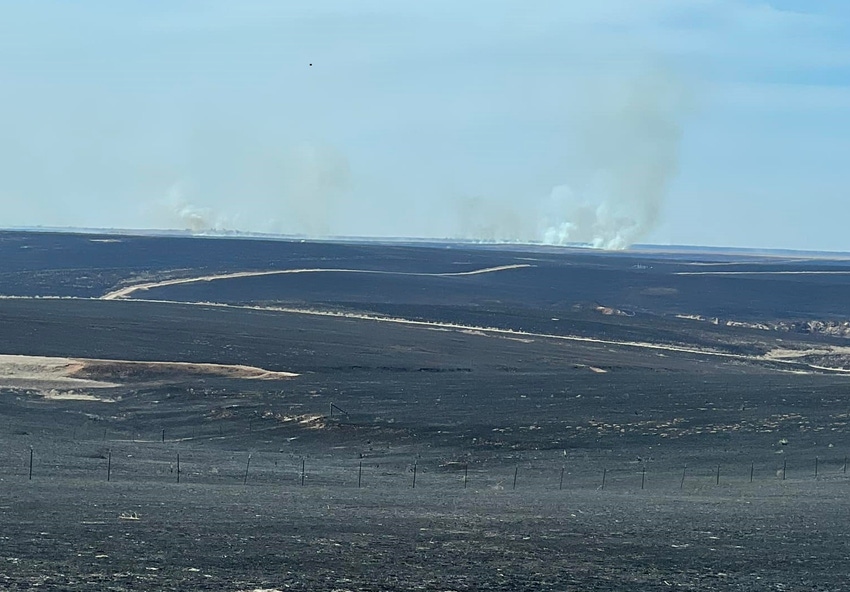Smokehouse Creek Fire becomes largest in Texas history
Over 85% of Texas cattle population located in Panhandle.

The Texas A&M Forest Service reported Thursday morning that the Smokehouse Creek Fire has now burned 1.075 million acres and is only 3% contained, making it the largest wildfire in Texas history. Several other fires continue to burn in the Panhandle, including the Windy Deuce Fire, which has now burned 147,000 and is only 30% contained.
Texas Agriculture Commissioner Sid Miller said Wednesday that farmers and ranchers are losing everything in the fires and that several grain and seed operations have also reported total losses.
“These fires not only threaten lives and property but will also have a substantial impact on our agriculture industry. Over 85% of the state’s cattle population is located on ranches in the Panhandle. There are millions of cattle out there, with some towns comprising more cattle than people. The losses could be catastrophic for those counties,” Miller said.
In a Thursday morning social media post, Texas A&M AgriLife Extension Service in Hemphill County reported “massive losses of ranch land (over 400,000 acres in Hemphill County alone), scores of homes destroyed, literally thousands of cattle lost and much more than can be described.”
As Texas Gov. Greg Abbott declares a disaster in 60 counties, the Texas Department of Agriculture’s State of Texas Agriculture Relief Fund (STAR Fund), is calling for donations to assist Texas Panhandle farmers and ranchers. The STAR Fund mobilizes resources to support affected agricultural producers.
Funded 100% through donations, TDA reimburses qualified agricultural producers 50% of eligible expenses. STAR Fund financial resources cannot be used as compensation for crop or livestock losses but rather to help rebuild fences, restore operations, and cover other expenses related to agricultural disaster relief and restarting operations.
“Donations will go a long way toward rebuilding the Panhandle,” Commissioner Miller added. “We stand in solidarity with our farmers and ranchers facing loss and destruction. Our thoughts and prayers are with them during this challenging time, and we're committed to supporting their recovery efforts every step of the way.”
If you are in emergency need of hay to feed livestock please visit TDA’s Hay Hotline here.
To donate or for more information on the STAR Fund please follow this link.
The Texas A&M AgriLife Extension Service said Thursday that donations of hay, feed, fencing supplies, cow feed and milk replacer are needed to support livestock owners are needed for those affected. It is establishing Animal Supply Points in several locations in the region to accept the donations. The purpose of the Animal Supply Point is to meet area producers’ most critical needs such as providing feed for cattle while they assess their individual operation’s other needs. A list locations can be found here.
Meanwhile, Texas & Southwestern Cattle Raisers Association (TSCRA) is urging donors to give to the TSCRA Disaster Relief Fund to aid victims of the ongoing natural disasters.
“A fire is one of the most tragic events that can impact ranches, and a natural disaster such as the widespread wildfires in Texas and Oklahoma can result in financial hardships and deep impacts to our ranching communities,” said TSCRA President Arthur Uhl. “Texas & Southwestern Cattle Raisers Association is here to help through means of financial assistance and we’re encouraging those who can to donate to the TSCRA Disaster Relief Fund.”
For more information, including how to donate and how to apply for funding visit tscra.org/disaster-relief-fund/ or contact TSCRA at 800-242-7820. Additional resources for victims impacted by these wildfires are also available tscra.org/disaster-relief-fund/.
Oklahoma wildfires still burning
Crews in neighboring Oklahoma also continue to battle several active wildfires. In a Feb. 28 update, the Oklahoma Forestry Service reported that the Catesby Fire in Ellis County has burned 90,570 acres and is 18% contained. The Slapout Fire in Beaver County has burned 26,048 acres and is only 22% contained.
About the Author(s)
You May Also Like




.png?width=300&auto=webp&quality=80&disable=upscale)
